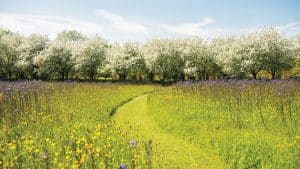You should stop mowing your lawn at least for a month this season, according to gardening experts – here’s why.

You should stop mowing your lawn this spring, a growing number of professional gardeners are saying. The BBC Gardeners’ World presenter Monty Don is leading the trend by calling on gardeners to take a more relaxed approach to mowing their lawns to allow nature to thrive. In an interview with Radio Times, the gardening guru was unequivocal in his aversion to neatly mowed lawns: ‘Cutting grass burns lots of fossil fuel,’ he explained, also adding that it ‘makes a filthy noise, and is about the most injurious thing you can do to wildlife.’
The no-mow trend is gaining momentum across the gardening community. The wildflower conservation charity Plantlife runs an annual No Mow May challenge, which encourages people to share their experiences of letting the grass and wildflowers grow, or even learning how to plant a wildflower meadow in the process.
And while Monty Don’s impassioned warning against over-mowing has attracted some criticism on social media channels, gardening experts wholeheartedly agree with the presenter: letting your grass grow is one of the best wildlife garden ideas there is.
‘If you only do one thing this year to improve your garden’s value for nature, be more like Monty and cut your grass less, or not at all,’ says Sarah Mead, Head Gardener at Yeo Valley Organic and creator of the Yeo Valley Organic Garden in Somerset. ‘Monty is absolutely right to highlight our obsession with keeping our lawns neat and tidy, and frankly I was shocked to read how much negativity he has faced as a result of his recent Radio Times interview. Come on gardeners, would a little less cutting really be such a bad thing?!’
The UK’s climate is perfectly suited to allow grass and the many species of beneficial plants that share our lawns to thrive, but regular cutting deprives essential pollinators of an important food source. According to Plantlife, allowing your lawn to grow naturally for just a single month can provide enough nectar for 10 times the number of bees and other pollinators than a regularly cut lawn.
Sarah concludes, ‘Global biodiversity is in decline, and our climate is warming. It’s essential that we all recognise the small changes we can make that have a huge collective impact on our environment. Putting your feet up instead of getting the mower out is top of the list!’
Sarah makes an important point: not mowing your lawn this spring may help redefine your relationship with your garden, making it more about relaxation and quiet – and watching bee friendly plants grow. If you do like keeping active in the garden, you can always give yourself a challenge by growing a new plant, starting a vegetable patch, or building a bird box or a home for a hedgehog.
Monty Don’s tips on getting the perfect lawn and the mistakes you’re making
Growing a beautifully lush lawn is easier than you think, thanks to this advice from the celebrity gardening expert.
With spring just around the corner, your lawn will already be coming back to life, so now is the ideal time to improve its condition for the seasons ahead. To get the best from your grass this year, heed the advice of celebrity gardening expert Monty Don.
In the new edition of his book, The Complete Gardener, Don revealed that at his own garden at Longmeadow, Herefordshire, he doesn’t strive for a pristine lawn – just ‘an even-ish area of green dominated by grass’. He is not troubled by a few weeds or even a bit of moss.
Don firmly believes that if the grass is healthy then everything else will look after itself.
‘To get a “good” lawn you have to think positively,’ he revealed in a recent blog post. ‘Put your efforts into healthy grass rather than fighting perceived “problems” like daisies, moss, ants, worm-casts, moles, plantains, dandelions and fairy rings.’
However, he stressed that the most common problem for lawns is lack of drainage – and for the best grass your soil does need to be well drained.
‘Moss, for example, is always a symptom of poor drainage, made worse by shade,’ he says. ‘Unfortunately even the best prepared soil becomes compacted by matted roots, rain and, especially, normal family use.’
Don explained that to solve the issue it’s important to work on the soil at least once a year. He does this by ‘sticking a fork in the ground and wiggling it about’, repeating the process every 6 inches or so.
To get the right mix for your soil, Don advises that you should combine equal portions of sieved topsoil, sharp sand and sieved leaf mould or compost. ‘Spread it across the area you have pricked and brush it in with a stiff broom, filling the holes with the mixture,’ he says. ‘This will help drainage and feed the grass.’
Don also suggests running a wire rake over the lawn to get rid of excess thatch and moss, and to allow light and water to get to
the roots in the soil. However, you should not be cutting back the leaves of spring bulbs at this stage – they need to be allowed to die back naturally as they absorb their energy for next year’s flowers through their leaves.
Finally, you should finish by mowing the lawn. ‘Do not cut it too short,’ he says. ‘Just give it a light trim for the rest of this month and the grass will be a lot healthier – and better able to resist summer drought – as a result.’
(Article source: Various)


I thought we were talking about what is healthy for lawns. How to have a better LAWN! This is all about saving fuel and taking care of bees. All good topics, but it’s not about lawns